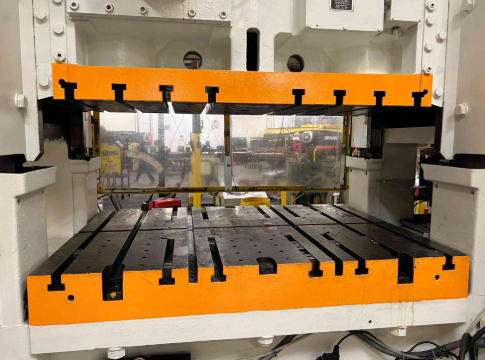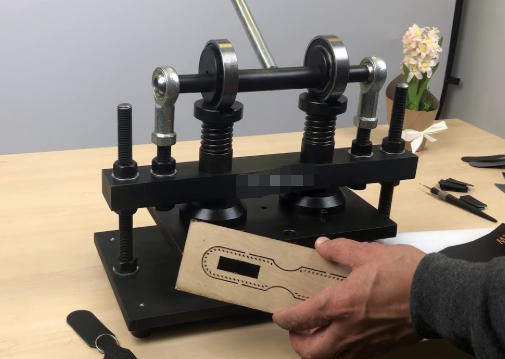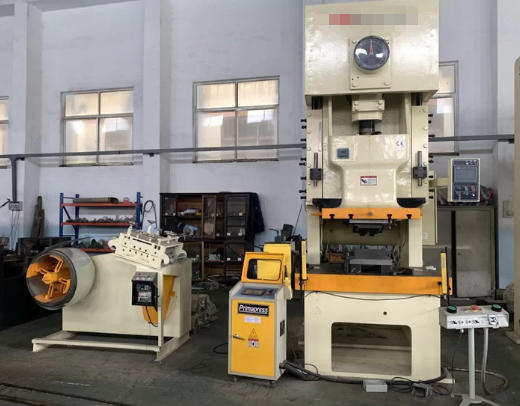Views: 222 Author: Rebecca Publish Time: 2025-11-17 Origin: Site









Content Menu
● What is a Punch Press Machine?
>> Use in Cutlery Manufacturing
● What is a Turret Punch Press?
>> Benefits for Cutlery Production
● Key Differences Between Punch Press Machine and Turret Punch Press
● Detailed Comparison of Operation and Capabilities
>> Formation and Punching Complexity
>> Production Speed and Output
● Technological Advancements in Turret Punch Presses
● Choosing the Optimal Machine for Your Cutlery Manufacturing
>> Material and Part Complexity
● Maintenance and Operational Best Practices
● Frequently Asked Questions (FAQs)
>> 2. Can turret punch presses perform forming functions like bending and embossing?
>> 3. How do production speeds compare between the two machines?
>> 4. What are the main maintenance challenges for each machine?
>> 5. Which machine is better for start-up cutlery manufacturers?
In the cutlery manufacturing industry, metal forming and sheet metal punching are foundational to producing high-quality products like knives, forks, spoons, and various utensils. Punch press machines and turret punch presses are two pivotal types of equipment used for shaping, cutting, and punching metal sheets. Though both are designed to perform similar tasks, they differ in mechanics, tooling flexibility, automation, and application suitability.
This article provides an in-depth comparison of punch press machines and turret punch presses, with special emphasis on their roles in the foodware manufacturing sector. By examining their structure, functionality, advantages, and practical use cases, manufacturers can make informed decisions on the best machinery fit for their production processes.

A punch press machine is a mechanical or hydraulic device used for cutting holes or forming shapes in metal sheets by pressing a punch into the metal against a die. It applies significant force to deform or shear the metal, creating precise cutouts, slots, or indentations.
Punch presses come in different varieties, including mechanical, hydraulic, pneumatic, and servo-driven types. The essential components include:
- Ram or Slide: The moving part holding the punch.
- Punch: The tool that forms or cuts the metal.
- Die: The counterpart tool that supports the metal and shapes the punched area.
- Bed: The flat surface where the metal sheet lies.
Mechanical punch presses usually operate using an eccentric crank mechanism, driving the ram vertically to produce fast, repetitive punches. Hydraulic presses use fluid pressure for slower but more forceful punches, suitable for thick or tough materials.
In the cutlery industry, punch press machines are extensively used to create holes for rivets, shape handles, or produce decorative embossing on metal sheets. Their ability to handle thick metals ensures sturdy product components, especially in heavy-duty cutlery like chef knives or multi-piece sets.
A turret punch press is a modern, automated type of punch press that integrates a rotating turret capable of holding multiple punch tools. This turret mechanism allows the machine to quickly switch between different types and sizes of punches without manual intervention.
The turret typically contains 16, 24, 32, or more stations, each loaded with a different punch and matching die. The turret rotates to align the desired tool under the ram, which then performs the punching. The metal sheet is positioned automatically by CNC-controlled feeding systems for precise and repetitive punching.
The turret punch press shines in manufacturing environments where varying cuts, holes, and shapes are needed with minimal downtime. For cutlery manufacturing, this means:
- Complex decorative patterns can be punched in one setup.
- Switching between hole sizes and shapes for rivets and designs becomes much faster.
- Higher output rates are achievable with less manual labor.

| Feature | Punch Press Machine | Turret Punch Press |
|---|---|---|
| Tool Configuration | Single punch and die set at a time | Multiple tools in rotating turret |
| Tool Change | Manual or semi-automatic, labor-intensive | Fully automatic, rapid indexing |
| Speed of Operation | Slower due to manual tool change | Fast due to quick tool changes and CNC control |
| Flexibility in Punching | Limited to the set punch and die for the job | Highly flexible with multiple tools ready to use |
| Material Thickness Suitability | Handles thicker materials effectively | Generally suited for thinner to medium thickness metals |
| Forming Capability | Limited by die and ram clearance | Higher forming capability with larger feed clearance |
| Automation | Basic to moderate depending on CNC integration | Highly automated with advanced CNC control |
| Space and Footprint | Smaller, compact design | Larger due to turret and tool storage |
| Maintenance Complexity | Easier maintenance with fewer components | More complex due to turret mechanism and electronics |
| Cost | Lower initial investment | Higher investment but often more cost-effective long-term |
Punch press machines require manual or semi-manual tooling changes. When switching from one operation to another—say, changing from a hole punch to an embossing tool—production must pause, and tools must be changed and aligned. This can lead to longer downtime in shops making multiple cutlery variations.
In contrast, turret punch presses reduce this downtime drastically. Multiple tools are pre-loaded on the turret, and CNC programming allows for automatic tool indexing. This means different operations on the same or different pieces can occur in one run, dramatically increasing throughput and flexibility in customization.
Turret punch presses can achieve more complex patterns and shapes in sheet metal without multiple setups. They also allow forming operations like bending, flanging, embossing, and marking—all in one machine.
Punch presses, mainly mechanical types, typically focus on simple hole punching or blanking with less capability for complex forms or secondary operations.
Due to automated tool changes and CNC-controlled feeding, turret punch presses operate at higher speeds—sometimes exceeding 600 hits per minute in advanced models—making them ideal for mass production of cutlery components.
Punch presses, with manual or slower tool changeovers, generally have lower cycle times but can handle heavier materials requiring more force.
Recent models feature servo-electric drives replacing hydraulic systems, which reduce energy consumption and maintenance costs significantly. They also introduce smart monitoring systems for tool wear, automatic turret loading, and advanced CNC controls for optimizing cutting paths and punch sequences.
Such technologies improve precision, reduce waste, and enhance energy efficiency—all vital factors for modern cutlery manufacturers aiming at high-quality, eco-conscious production.
- Low to Medium Volume: Punch press machines are economical and produce consistent quality for smaller batches or custom jobs.
- High Volume with Variation: Turret punch presses are suited for factories with large order volumes and diverse product ranges requiring quick tooling changes.
- Thicker, Heavy-Duty Parts: Punch presses deliver the force needed for thicker steel or reinforced cutlery.
- Thin to Medium-Thickness, Complex Designs: Turret presses excel with thinner stainless steel sheets and intricate patterns.
Investing in a turret punch press will mean higher upfront costs and larger space, but it lowers operational costs across high-volume runs. Punch presses are budget-friendly for startups or workshops with smaller footprints.
To ensure longevity and quality:
- Keep punch and die sets sharp and correctly aligned.
- Regularly lubricate moving parts and clean turret mechanisms.
- Train skilled operators for CNC programming and troubleshooting.
- Schedule preventative maintenance to avoid unexpected downtime.
- Monitor tool wear with modern sensors where available to replace dies proactively.
Punch press machines and turret punch presses each have unique strengths tailored to different production requirements within the cutlery manufacturing industry. Punch press machines are robust, relatively simple, and best suited for heavy-duty punching in lower to moderate volumes. Turret punch presses, with their automation, rapid tool change capability, and CNC control, are indispensable for high-volume, complex-cutlery manufacturing requiring flexibility and speed.
An optimized factory layout often benefits from using both machines strategically based on product design, order size, and material characteristics. Understanding their differences and matching these machines to the right applications ensures improved productivity, consistent quality, and cost-effectiveness in cutlery production.

Both machines handle stainless steel, aluminum, and other metals used in cutlery. Punch presses are preferred for thicker metals, while turret presses are efficient with thin-to-medium thicknesses.
Yes, modern turret punch presses offer forming capabilities such as bending, embossing, flanging, and marking, reducing the need for secondary machines.
Turret punch presses operate at higher speeds with automated tool changes, enabling faster production cycles. Punch presses have slower cycle times due to manual tool changes but excel in heavy-duty applications.
Punch presses require regular inspection of the ram and punch/die alignment. Turret presses demand upkeep of the rotating turret mechanism, CNC systems, and automated components.
Start-ups often choose punch press machines for lower initial costs and simpler operation, while established manufacturers may invest in turret punch presses for scalability and automation benefits.
Why The Right Punch Press Machine Is Crucial for High-Quality Tableware Production?
Punch Press Machines: The Backbone of Efficient Cutlery Production
How To Choose Between Manual And Automatic Punch Press Machines?
Best Punch Press Machines for Small And Large-Scale Manufacturers
Top Manufacturers of Punch Press Machines for The Tableware Industry
What Are The Key Benefits of Investing in A Punch Press Machine for Your Factory?
How Punch Press Machines Are Revolutionizing The Cutlery Industry?
The Role of Punch Press Machines in Modern Kitchenware Production Lines
Punch Press Machine Vs. Turret Punch Press: What's The Difference?
